Family : Phasianidae

Text © Dr Davide Guadagnini

English translation by Mario Beltramini
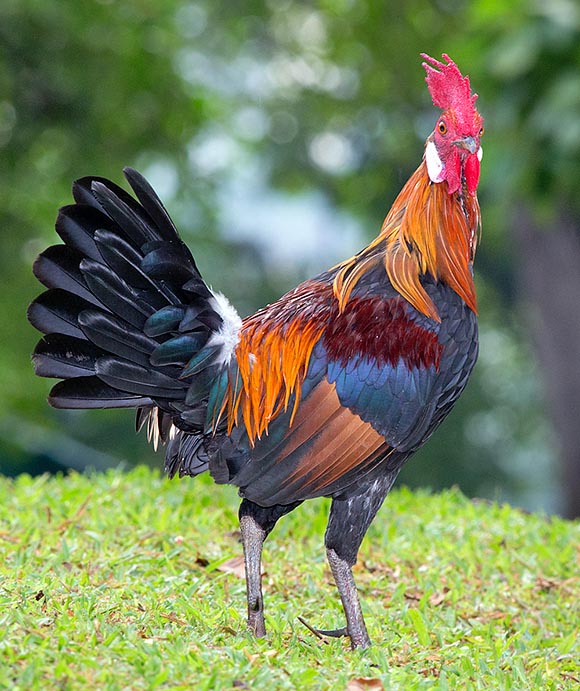
Gallus gallus, ancestor of the doemstic cock, can be found, with several subspecies, in an ample belt of south-eastern Asia. If disturbed iy quickly flies away © Giuseppe Mazza
The Wild red fowl or Bankiva fowl or Red junglefowl (Gallus gallus Linnaeus, 1758) belongs to the well known order of the Galliforms (Galliformes); to the family of the Phasianids; to the genus Gallus and to the species Gallus gallus.
This species, along with the congenerous species Gallus sonneratii and Gallus lafayetii, form one superspecies. The wild fowl can locally hybridize with the Sonnerat’s junglefowl or Grey junglefowl (Gallus sonneratii ).
Five subspecies are generally recognized:
Gallus gallus gallus (Linnaeus, 1758) distributed in eastern Thailand through Kampuchea, in central-southern Laos up to central-southern Vietnam.
Gallus gallus spadiceus (Bonnaterre, 1791) distributed in central-southern China (south-west of Yunnan), in Burma, in part of Thailand, in the Malaysian Peninsula and in northern Sumatra.
Gallus gallus bankiva (Temminck, 1813) distributed in southern Sumatra, Java and Bali.
Gallus gallus murghi (Robinson & Kloss, 1920) distributed in northern and north-eastern India close to Nepal and Bangladesh.
Gallus gallus jabouillei (Delacour & Kinnear, 1928 present in central-southern China (south-east of Yunnan, Guangxi and Hainan) and in northern Vietnam.
The name of the genus and of the species “gallus” comes from the Latin name given by Linnaeus to this species (Phasianus gallus) and that, in its turn, comes from the classification of the domestic chicken: “farm chicken” or “hen” assigned to the domestic chicken, descendants from this wild species, by several authors: Gesner (1555), Aldrovandus (1599), Willughby (1676), Albin (1738 from “bantam chicken” from “Bantam”, in India).
Zoogeography
The red junglefowl is distributed, with its various subspecies, in an ample belt of south-eastern Asia: from northern India to the islands of Sumatra, Java and Bali passing through China, Thailand, Laos, Vietnam and the Malaysian Peninsula. The species is also present in the Philippines, in Sulawesi and in part of the Lesser Sunda Islands; in these areas, the species has been probably introduced.
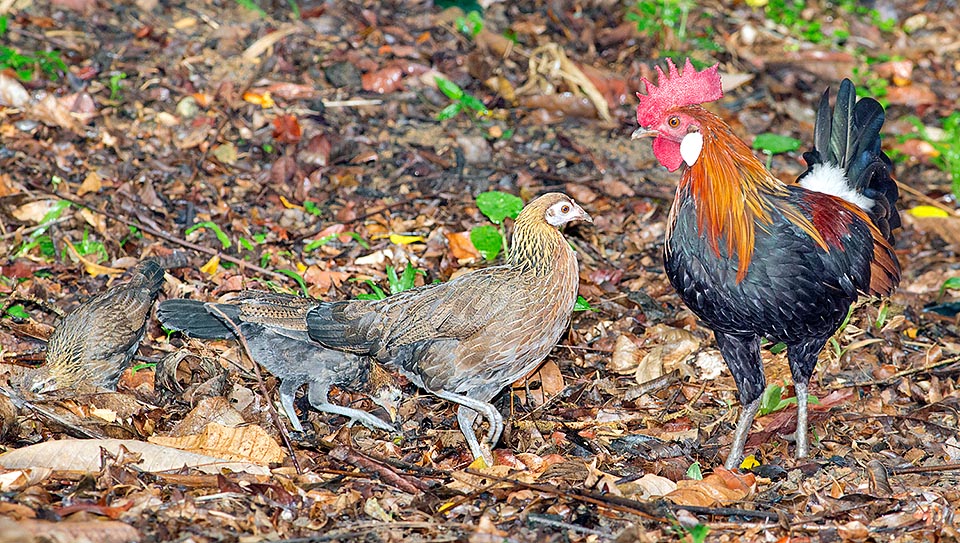
Family picture in Singapore underwood forest. We see at once a marked sexual dimorphism evidenced by strong difference of colour and shape of feathers, not to forget crest and wattles. Also, the male (65-75 cm) is much bigger than the female (42-46 cm) here shown with two already grown chicks © Giuseppe Mazza
Ecology-Habitat
Through the vast distribution range it occupies various tropical and subtropical habitats, including environments seemingly not suitazble such as mangrove forests. The red junglefowl lives therefore from the sea level up to 2000 metres of altitude. The species appears to prefer lands flat or with light slopes, zones at the margin of the forest and habitats formed by secondary forests.
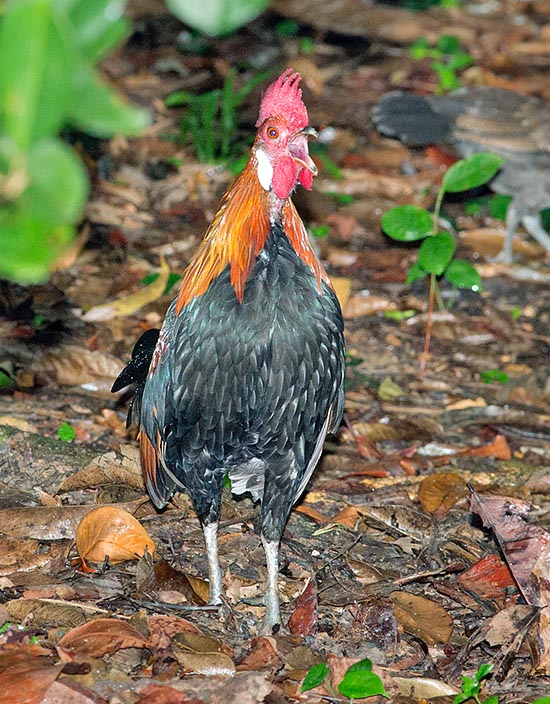
Males vocalizations are shorter and clumsier than our domestic cock ones. They serve to attract the females and as warning signal for obtrusive males © Giuseppe Mazza
The male, cock, is about 65-75 cm long and weighs about 670-1450 g. The female, hen, is about 42-46 cm long and weighs about 480-1050 g.
The red junglefowl is the ancestor of the domestic chicken (with some hybrid descendence by the Grey junglefowl, Gallus sonneratii), selected in all the world in an huge variety of forms, liveries, size and productive attitudes.
The red junglefowls have a marked sexual dimorphism shown by a strong difference of colour and shape of the feathers and of the fleshy appendages of the head (crest and wattles).
In the male (cock) the neck (during the reproductive season) presents abundant and quite long feathers mainly orange-reddish-golden, overall more nuanced pale golden in the central-predistal part of the camail (in some subspecies they are marked dark).
The dorsal parts of the body are always orange red. The wing has orange brick red remiges with black distal portion ; the intermediate coverts are dark iridescent green and small upper coverts of dark velvet red colour.
The tail is black-dark green iridescent, with violet-blue reflections and is formed by some quite typical falciform feathers, the dorsal basal part shows a soft feathery white zone. The top of the chest is reddish-orange. The low chest and the ventral parts are glossy black.
The head is adorned with a typical red crest, hanging wattles of the same colour and the always red facial skin (it may be white or whitish-light blue-violaceous at the level of the lateral big ears in some subspecies).
The beak is grey-horn-yellowish and the iris is orange. The legs, fairly robust, are typical of a scratching galliform, are equipped with four fingers (with nails) of which three pointing forward and one backward. The legs are grey or greenish-grey and over the “foot”, behind, have a sharp spur used by the cocks for the fightings among conspecifics.
The female (hen) has a more modest brown colour, the feathers of the neck are anyway more golden-yellow marked dark.
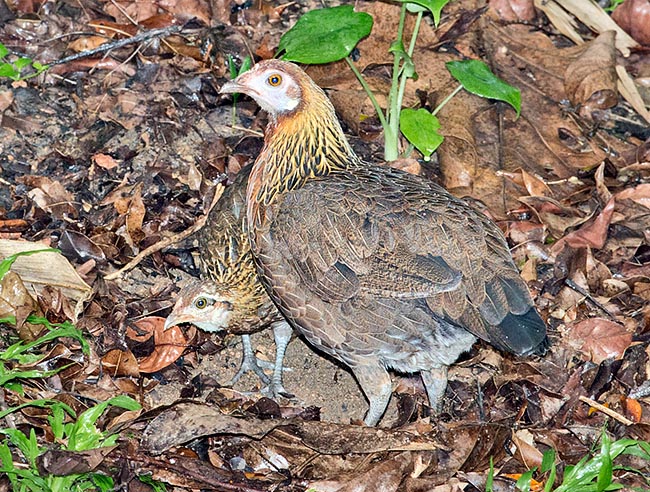
The female and young livery is extremely cryptic in the underwood © Giuseppe Mazza
The remiges have a very slight dark spotting and the tail is mre blackish. The beak is grey-horn and the iris is brown. Crest and wattles are of reduced size and little red (pinkish-opaque-dark grey).
In the females the whole of these characters determine a more cryptic look, fundamental especially when they are hatching and take care of the progeny. Also the females may have at times small spurs more or less pronounced.
Ethology-Reproductive biology
The red junglefowl has omnivorous and opportunistic alimentary habits modifying the feeding preferences in a seasonal way depending on the varying of the trophic availabilities.
A research has revealed that, in India, the gastro-intestinal contents of 37 specimens was formed by seeds of about thirty species of plants and invertebrates belonging to many taxa.
The plants identified, as aliment, included the genera Trichosanthes, Rubus, Carissa, Zizyphus and Shorea; the only species isolated belonging to cultivated ones has been the rice (Oryza). A vast range of different aliments have been detected also in the goiters of 23 birds seized in Thailand; these ones included fruits of plants belonging to the family of the euphorbiaceous (Euphorbiaceae) and to the genus Zizyphus, seeds of bamboo (tribe Bambuseae).
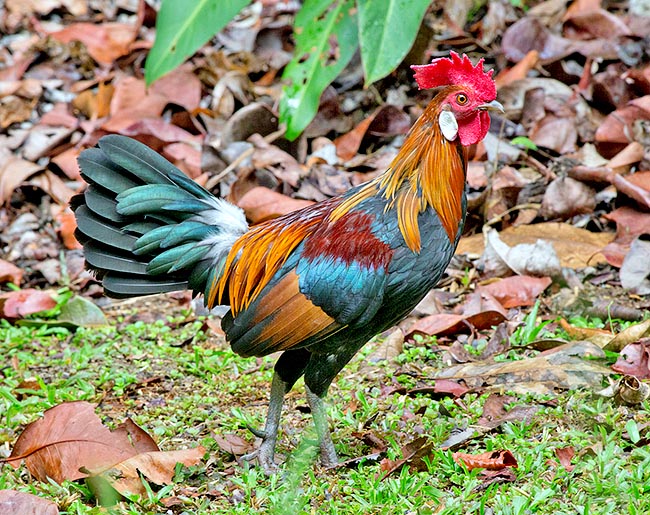
When courting the male is noted not only by the singing or by the feathers, but offer greedy gifts to the partner © Giuseppe Mazza
The red junglefowl reproduces in March-May, during the dry season, even if depending on the various geographig distribution ranges the depositions are much variable. In fact: in different parts of India they have found eggs also between January and October; in Bangladesh it reproduces between March and June; in the Malaysian Peninsula it reproduces between December and May (with a peak between January and February); in China it nests between February and May (at least as per what observed in the region of southern Yunnan). The species has polygamous habits. The nests can be located in quite different sites even if typically placed in secondary forests with thick vegetation of in bamboo forests; the nests are hidden under bushes or inside tufts of bamboo. The hatch is usually formed by 5-6 (4-10) eggs of pale pink-whitish colour and the hatching, done only by the female, lasts 20-21 days.
The chicks, precocious, abandon the nest follwing the mother who accompanies them looking for food, protecting them and warming them up. The newborns are covered by reddish yellowish down with dark brown-blackish striations in the dorsal part and in the head (lateral stripes of the head surround the eyes); the latero-ventral parts are yellow-whitish, chest usually light brown. The feathered young, when small are more similar to the female even if the young males are precociously distinguishable due to the reddish-yellowish nuances of the camail and of the rear-back.
The differences among the various subspecies of red junglefowl are more related to the differences of colour, of shape and of length of the feathers forming the camail (neck feathers) during the period of the reproduction.
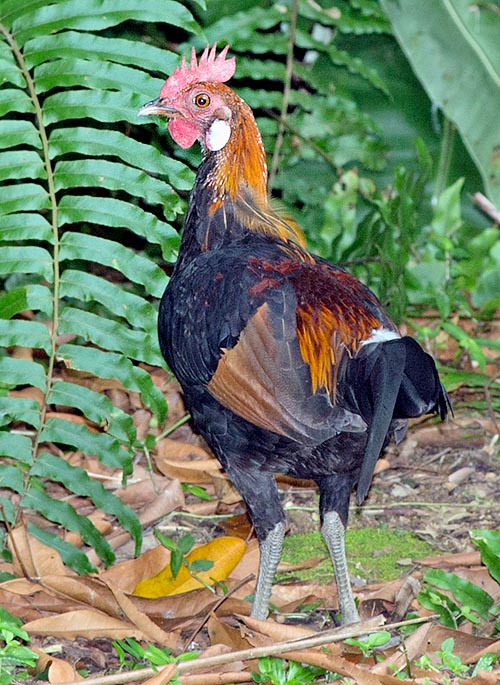
As often occurs in the anatids, also the wildfowls, after the reproductive time, show a faded livery called ecclipsal. Less turgid and flamish crest, dark-opaque bare neck, and loss of the nastriform-thin feathers of the upper tail © Giuseppe Mazza
These differences are detectable during the reproductive period because this species (analogously to what referred for many species of anatids) shows a nuptial livery differing from a second one, not reproductive, eclipsal.
The difference between the two liveries concentrates at level of the feathers of the neck: long and colourful (red-yellow) during the period of nuptial livery and short and dark (black or opaque blackish) during the period of eclipsal livery that appears after the summer moulting and lasts from June to September.
In the eclipse period, the cock, presents also less turgid and less coloured crest and the loss of the nastriform-thin feathers of the over-tail forming a sort of a dorso-latero-caudal “shawl”. The feathers of the neck are more red and rounded in the subspecies bankiva; pointed and dark marked in the subspecies murghi; are of intermediate type in the subspecies jabouillei that presents also small feathers of the neck and crest and absence of white at level of the “earlobes” (lobes at level of the ear), the females of this subspecies are usually rather dark if compared to the females of the other subspecies.
The red junglefowl has sedentary habits and simply is not present in the climates not suitable of its own range even if, however, seemingly the birds move to lower altitudes in winter, at least in northern Thailand.
During the mating season (but also out of this period) the cocks “sing” as do the well known domestic cocks, but, with respect to the latter, emitting shorter vocalizations, more ingainly and that brusquely they interrupt (like “broken”). The vocalizations of the males have the purpose to attract the females as well as to act as warnings for the other males.
The junglefowls (and the domestic chicken too) emit also a certain variety of different vocalizations that, particularly, inform specifically the conspecifics about the presence of aerial or terrestrial predators arousing consequent different defensive answers.
The cocks court the hens offering mouthfuls (something like what the brooding hen does with the chicks) that are continuously collected and dropped with the beak till the female accepts them pecking them from the ground or directly from the male beak. The courting displays foresee also the approach to the female trying to surround it with own body spreading to the ground the wing facing the female.
The red junglefowl, like the other congeneric species, has purely terricolous habits and the flight is mainly done for reaching the night perches (overhead branches) or for excaping possible predators when cornered.
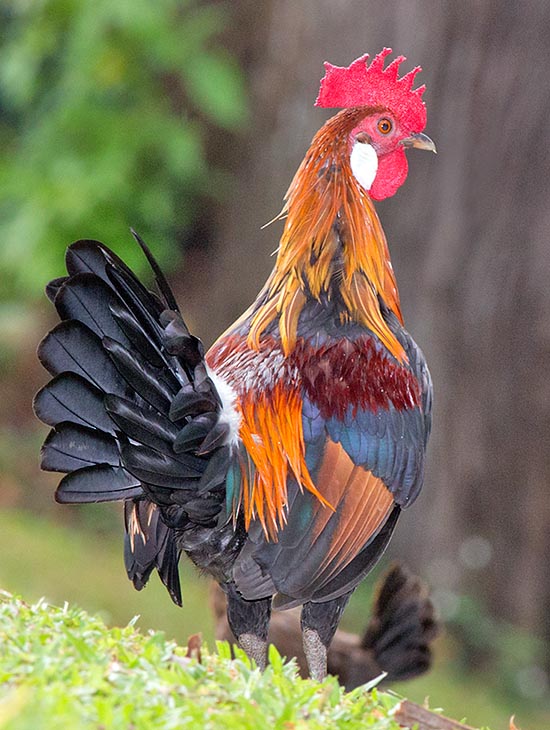
Even if in Singapore the units are counted on the fingers, this species, globally, is not seriously indangered, but runs the serious risk of extinction due to hybridization with domestic chicken © Giuseppe Mazza
The species, taken as a whole, does not result being endangered also thanks to its adaptation capacity; we have seen that it lives in an ample variety of habitats, including areas with secondary vegetation and artificial habitats like the plantations of African oil palms (Elaeis guineensis) and rubber trees (Hevea brasiliensis).
In Thailand, the red junglefowl is still considered as common in spite of being victim of continuous persecutions. In Indonesia, the species is decreasing because of the hunting and of the progressive and rapid loss of habitat. Not particularly common in Java, in Sulawesi (where it is heavily hunted) and on the Lesser Sunda Islands; more present in Sumatra. In India, the junglefowl is more stable in the protected areas but decreasing in all other areas due to the environmental degradation and the excessive hunting. The species was locally common in some areas of Nepal, but during the last years the population has declined and has disappeared in some zones.
In some areas of its habitat the species is protected but in many others, unfortunately, the law does not foresee any rotection practices.
Unluckily the species, generally speaking, runs serious risks of extinction because of the presence of domestic chicken bred freely at the margins of the forests with whom they may easily hybridize.
The junglefowlhas been domesticated in Asia more than 5000 years ago originating the various domestic forms (Gallus gallus domesticus); then has diffused all over the world with an enormous variety of productive races (and also ornamental) becoming the most bred animal at global level and the main source of production of proteins of animal origin (meat and eggs) for the human species.
The red junglefowl, maybe also due to the resemblance with some domestic races derived from the same, is not very present in the ornamental aviaries; and when present is often bred with a grade of unsure purity. The domestic races, coming from the red junglefowl, have been selected for the production of meat, eggs, feathers, for fighting and for ornamental purposes.
Many are the races obtained and differ so much among them that some do not absolutely look like the wild progenitor, a little like what has happened for the wolf (Canis lupus) in comparison to some races of dogs (Canis lupus familiaris) coming from it. The domestic races of chicken have been selected also for the colour of the eggs that vary from white to pale pink to dark, almost brown pink to the unusual light-blue eggs laid by races selected in South America.
Synonyms
Phasianus gallus Linnaeus, 1758.
→ To appreciate the biodiversity within GALLIFORMES please click here.
